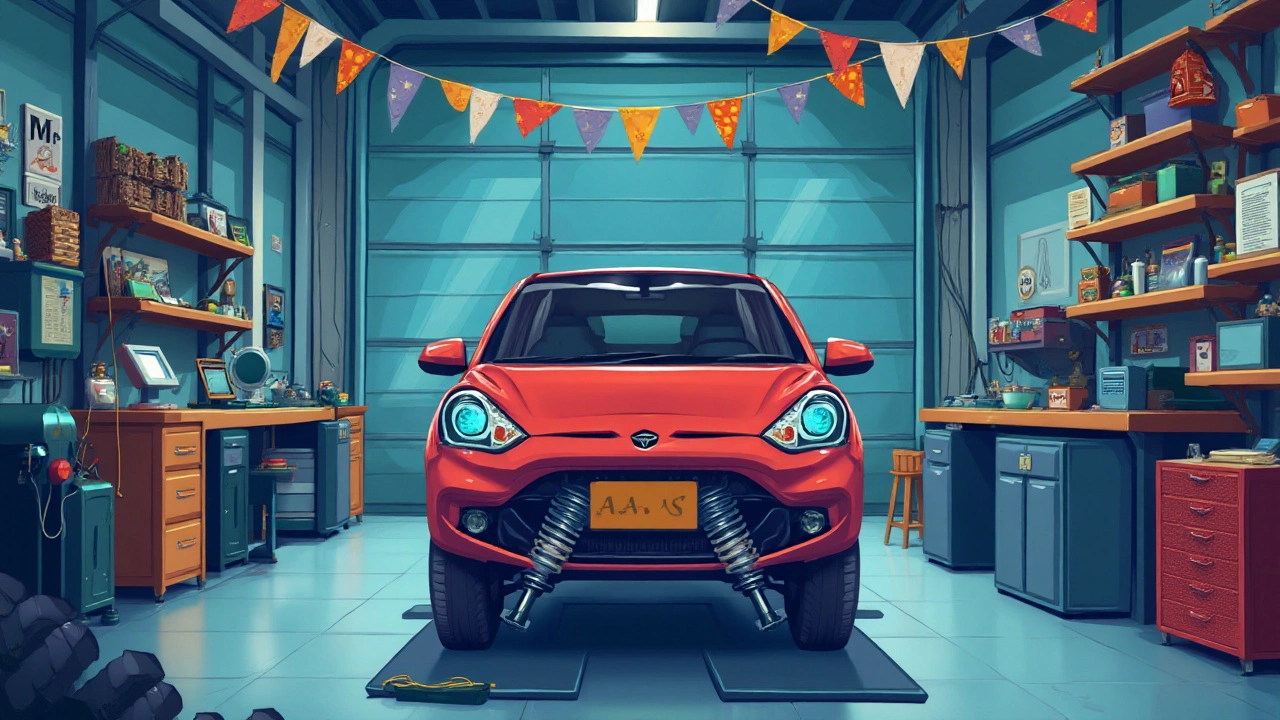Detecting and Fixing Bent Suspension Parts in Your Vehicle
 Jan, 17 2025
Jan, 17 2025
Ensuring your vehicle operates smoothly doesn't just involve checking the engine or the tires—your car's suspension system plays a crucial role in its performance and overall safety too. However, even the most robust suspension systems aren't immune to damage. A bent suspension can sneak up on you, causing a myriad of problems that often manifest in subtle ways.
Recognizing the signs of a bent suspension early on can save you a heap of trouble down the road. From unusual noises that make you wince to that uneasy feeling every time you steer, the symptoms might be more telling than you think. So how do you discern these issues, and what can you do if you suspect something's amiss? Let's uncover the essentials that every car owner should know.
In this guide, we’ll walk you through everything—from understanding your suspension system, identifying the clues of a bent component, to practical advice on inspection and repair, whether you're a do-it-yourself enthusiast or someone who prefers to seek professional help.
- Understanding Suspension
- Signs of Bent Suspension
- Common Causes of Damage
- Inspection Techniques
- DIY vs. Professional Repair
- Preventive Maintenance Tips
Understanding Suspension
When it comes to your car's performance on the road, the suspension system holds an integral place in the vehicle's anatomy. It's more than just a collection of springs and dampers; it's a finely tuned network that absorbs all the bumps and jolts of the road, ensuring that your drive remains smooth and under control. At its core, the suspension system connects the vehicle to its wheels and allows movement relative to each other. This not only maintains effective steering but also ensures optimal friction between the tires and the road, crucial for safety and comfort.
Suspension systems generally comprise several key components: springs, shock absorbers or dampers, and struts. The springs, usually in the form of coil, leaf, or torsion bars, help absorb energy from road shocks. Shock absorbers work alongside springs to dissipate excess energy and prevent excessive bouncing. Struts are a structural part of the suspension system that combines the coil spring and the shock absorber into one unit, offering support to the suspension. Most modern vehicles use a combination of different technologies to provide the right balance of comfort and performance, leading to improved handling and stability.
Interestingly, changes in suspension technology have evolved tremendously, ever since the first patent was filed by Robert Hooke back in the 17th century. Today, innovations like adaptive suspensions and air suspension systems offer real-time adjustments in response to driving conditions. This advancement reveals just how far automotive engineering has come in enhancing driver experience and safety. As aptly quoted by renowned auto engineer Ferdinand Porsche,
"In the beginning, I looked around but couldn't find the car I dreamed of, so I decided to build it myself."His visionary words emphasize the continuous pursuit of innovation and excellence in the field of automotive technology, a drive that has led to the sophisticated suspension systems we see today.
To put it in perspective, a well-maintained suspension plays a critical role in the longevity of your vehicle. Properly functioning springs and dampers ensure that your tires are always in contact with the road, which is vital for safe braking and maneuvering. According to a study conducted by the National Highway Traffic Safety Administration, a compromised suspension increases stopping distances and decreases vehicle stability, particularly during emergency maneuvers. This only underscores the importance of regular maintenance and immediate attention to any unusual symptoms related to suspension.
In essence, the suspension system acts as a buffer between the wheels and the car body, taking on the hard work of cushioning the ride and maintaining tire alignment. While modern engineering has made these systems robust, they are not indestructible. Understanding their components and working mechanisms not only enables better maintenance practices but also prepares you for recognizing early signs of wear or damage, ensuring that your vehicle continues to perform seamlessly on asphalt or gravel alike.
Signs of Bent Suspension
When it comes to your vehicle's suspension, a slight bend can lead to a host of problems that shouldn't be ignored. It's essential to recognize these «suspension issues» early on. One of the first signs might be an unusual sound every time you drive over a bump or uneven surface. You'll often hear a clunking or knocking noise that wasn't there before. Such sounds indicate that components within the suspension may not be operating as they should. This noise might signal a «bent suspension» part that's struggling to cope with its misalignment, impacting the car's performance.
Beyond the audible indicators, you might also notice that your vehicle doesn't handle the way it used to. It might pull to one side or the steering wheel feels off-center when you're driving straight. These handling issues can be particularly telling, especially if the «car suspension» has been compromised. Poor handling affects the stability of your car on the road, making it a safety concern for both you and other drivers. Sometimes, this can be felt as an increased body roll while cornering, where the car leans more than usual. This is often a sign that the suspension isn't being supported evenly across all four corners.
Another revealing sign is uneven tire wear. If one tire, or perhaps a set of tires, seems to be wearing down faster than the others, it could be because the suspension isn't holding them correctly in place. This can lead to premature tire replacement, increased fuel consumption, and a potential blowout if left unchecked. Regularly checking your tire tread can provide an early hint that something deeper within the «vehicle» needs attention.
Curiously, a less obvious symptom but equally telling can be found in how your vehicle sits while parked. If you've ever noticed your car seems to lean to one side even when it's stationary on level ground, that could be a dead giveaway of a problem brewing beneath the surface. This lopsidedness might be mild and easily overlooked, but it typically suggests the springs or other suspension elements have been shifted out of place.
Interestingly, according to a survey by the National Highway Traffic Safety Administration, nearly 20% of suspension-related accidents are linked to unnoticed or ignored signs of damage.
"It’s the little indicators that often point to bigger issues," says John Hammond, a noted automotive engineer. "A vehicle should drive smoothly, sound right, and feel balanced; when it does not, it’s time to take a closer look."Regular check-ups and being attuned to changes in your car's behavior is crucial. Paying attention early can mean the difference between a simple adjustment and costly repairs down the line. Also, be conscious of your ride’s overall comfort. A rougher ride than usual, where passengers feel jostled more than normal, might suggest the dampening function of your suspension is not up to standard, alluding to potential distortion.
Adhering to these signs and symptoms not only aids in recognizing a «bent suspension» but allows you to be proactive in your «automotive maintenance» regime. Combining a bit of knowledge with attentive awareness will ensure your travels remain safe and efficient.

Common Causes of Damage
Your vehicle's suspension system is a complex network of parts, all working together to provide a smooth ride and ensure safety. The road, however, can be unpredictable, and several factors can lead to bent suspension components. Understanding these can help you take preemptive measures.
Potholes are a notorious culprit. These road menaces can catch even the most vigilant drivers off guard. When your car hits a pothole at speed, the impact can translate into a bending force, affecting various parts of the car suspension. The larger the pothole, the more significant the potential damage. Consideration of the financial cost repairs for pothole-related damage run into billions annually highlights the scope of their impact.
Another common cause is curb strikes. While maneuvering through parking lots or making sharp turns, accidentally striking a curb can seem minor. This action can be deceptively damaging, capable of altering the geometry of your suspension. This subtle change may not seem immediate but can lead to uneven tire wear and require suspension realignment.
According to a report by the American Automobile Association (AAA), more than 30 million drivers experience vehicle damage due to potholes annually.
The impact of off-road driving can't be ignored either. Adventurous as it may be, taking your vehicle off the beaten path subjects its suspension to unusual stress. Rocks, sudden dips, and uneven terrain put unusual pressure on suspension components, increasing the likelihood of them becoming bent.
Additionally, your car's load capacity should not be overlooked. Overloading your vehicle beyond its recommended weight adds stress on the suspension. Consistently bearing excessive weight will eventually compromise the vehicle's suspension, bending springs or damaging struts.
In withstanding these challenges, routine maintenance plays a vital preventive role. Regular inspections by a technician can intercept potential issues before they escalate. Professional advice, combined with mindful driving, can protect the integrity of your vehicle's suspension.
| Cause | Potential Damage |
|---|---|
| Potholes | Bent parts, misalignment |
| Curb Strikes | Suspension misalignment, tire damage |
| Off-road Driving | Stress on suspension, potential bending |
| Overloading | Spring and strut damage |
Inspection Techniques
Maintaining the integrity of your vehicle's suspension is crucial, as it plays an essential role in providing a smooth and safe ride. Knowing how to inspect it effectively can help you spot trouble before it escalates into a bigger issue. Inspection for a bent suspension usually involves a combination of visual checks and hands-on evaluation. Begin your inspection by parking your vehicle on a level surface, allowing you to get a better view and access to all suspension components.
Start with a visual inspection of your tires. Uneven tire wear is a telltale sign of suspension issues. If a tire appears more worn out on one side compared to the other, it could indicate a misalignment caused by a bent suspension. Actually, many mechanics will tell you tire condition acts like the messenger of many unseen issues. Look for unusual bulges or wear patterns. Don't forget to peek underneath to spot any sagging parts. A flashlight will be your best friend during this step, especially for those hard-to-see areas.
Next, focus on listening for unusual sounds. Clunks, rattles, or squeaking noises when driving over bumps might suggest a problem. While this might sound obvious, many tend to ignore these noises until they're omnipresent. This step can often direct you quickly to the area in need of closer scrutiny. While you're down there listening, take a minute to touch and feel the suspension parts. Check for any loose or dangling components.
The shaking test is another useful inspection technique. With your car securely parked, press down on the hood or trunk - a well-functioning suspension will cause the car to bounce smoothly and return to resting position. If it continues to bounce or feels unstable, this might indicate a bent suspension. Engaging your other senses, such as feel and sound, can pinpoint issues oftentimes better than just relying on vision.
Sometimes, a quick drive can be the best diagnosis tool in your arsenal. Pay attention to how your car handles when making sharp turns or driving over uneven surfaces. If the steering wheel feels off-center, or if you notice poor handling, it may be a result of suspension damage. It's always a good idea to note the specific conditions under which certain symptoms occur, as this information can be highly valuable when you consult with a professional mechanic later on.
The editorial team at MotorWeek advises, "Even the most minor misalignment can cause damage over time, leading to potentially costly repairs. Regularly checking for signs of wear and tear can safeguard your ride and your wallet."
Digital tools, like smartphone apps, can play a role in modern diagnostics, offering feedback on handling dynamics. However, they should not replace manual inspection. Tools are great, but don't rely on them blindly - use them as part of a comprehensive inspection approach. In case you're in doubt, or notice unusual symptoms that you can't quite place, it's always wise to seek a professional opinion. After all, an expert mechanic has the trained eye to catch nuances that might elude you.

DIY vs. Professional Repair
When your vehicle’s suspension starts acting up, particularly if you suspect it might be bent, the big question is whether you should roll up your sleeves for a DIY fix or wave the white flag and call in the professionals. Both approaches have their merits, and the choice largely depends on your comfort level with car repairs and the tools at your disposal. On one hand, diving into a DIY project can be immensely satisfying, not to mention the potential savings. Yet, it's crucial to weigh this against the risks of inexperience, where a botched job might end up costing more in the long run. Suspension systems are intricate, and improper repair might compromise vehicle safety—a gamble most aren't willing to take.
One compelling reason to opt for professional repair is the expert knowledge and specialized equipment they bring to the table. Garages typically have cutting-edge technology to detect issues that might not be visible to the naked eye, using diagnostic tools that give a comprehensive view of the suspension status. Moreover, professionals come equipped with years of experience, having encountered a wide variety of issues from different makes and models, giving them a sharp edge in swiftly identifying and addressing problems. As Brian Johnson, an experienced auto mechanic, succinctly puts it:
"When it comes to car suspension issues, sometimes what looks like a minor tweak needed may actually require major adjustment."
Yet, if you’re leaning towards a DIY approach, information availability is at an all-time high. Online forums and video tutorials make it possible for even inexperienced individuals to attempt repairs. For small issues, such as adjusting ride height or replacing a single shock absorber, this path might be a feasible option. Here’s a step-by-step outline for one such simple DIY task:
- Identify the issue by first conducting a thorough inspection of the suspension components.
- Gather all necessary tools – often a set of wrenches, screwdrivers, and possibly a jack or lift if you're going underneath the vehicle.
- Follow an exact guide specific to your vehicle make, studying any available visual aids carefully.
- Ensure that your workspace is safe and that all necessary protective gear is used, such as gloves and goggles, to prevent injuries.
- Proceed with caution, taking time to make precise adjustments and regularly double-checking your work.
- Test the vehicle under safe conditions to ensure that the fix has resolved the specific problem without introducing new issues.
Of course, ongoing vehicle maintenance is as much about prevention as it is about repair. Many professionals suggest regular check-ups before reaching critical wear points since a well-maintained suspension lasts significantly longer. Yet, there's a world of difference between keeping an eye on things and grabbing a wrench when problems arise. Understanding your limits, both in knowledge and technical prowess, is perhaps the most crucial part of making an informed decision in the DIY vs. professional repair dilemma.
Preventive Maintenance Tips
When it comes to keeping your vehicle’s suspension in tip-top shape, a little regular attention can go a long way. By adopting a proactive approach, you can extend the lifespan of your suspension components and ensure your rides remain smooth and trouble-free. First and foremost, make it a routine to inspect your suspension system at least twice a year, ideally before and after winter, which can be particularly harsh on your vehicle due to road salt and ice.
During these inspections, pay close attention to any signs of wear or damage—cracks, leaks, or bends in the springs, shocks, and struts. Hearing unusual squeaks when going over bumps or noticing uneven tire wear can indicate suspension issues. Address these minor issues immediately before they become more serious problems. Keep in mind that car suspension issues often creep up slowly, so detecting them early can save you money and ensure safety.
Another crucial tip is to maintain proper tire alignment and inflation. Misaligned tires can place uneven pressure on your suspension system, leading to premature wear and potentially, a bent suspension. Regularly rotating your tires and checking their alignment can mitigate this risk. Also, ensure that your driving habits promote healthy suspension life. Avoid driving over potholes and rough roads whenever possible, and if unavoidable, try to slow down to minimize impact.
"A healthy suspension system is pivotal in maintaining the balance and stability of a vehicle. Preventive care not only extends the lifespan but also enhances the driving experience," notes John Smith, an auto maintenance expert from the Mechanical Trust Group.
If you’re someone who occasionally finds yourself on rugged terrain, investing in quality, heavy-duty suspension components designed for such conditions can help. They might cost more upfront, but the durability pays off in the long haul. Also, it’s wise to schedule a professional check-up annually, providing an expert will catch what you might have overlooked and prevent costly repairs down the line.
For those enthusiastic about DIY car maintenance, refer to your vehicle's owner manual before undertaking any significant adjustment or replacement tasks. Manufacturers' guidelines offer specific instructions tailored to your vehicle model. Lastly, keep an eye on fluid levels in components like power steering. Low levels can strain your suspension, causing avoidable damage.
In essence, ensuring your suspension remains in excellent condition requires only a bit of vigilance and care, along with the necessary professional assistance when needed. By following these maintenance tips, you’ll likely avoid the significant hassles of suspension repair and enjoy a smooth drive, preserve your vehicle value, and most importantly, keep everyone safe on the road.